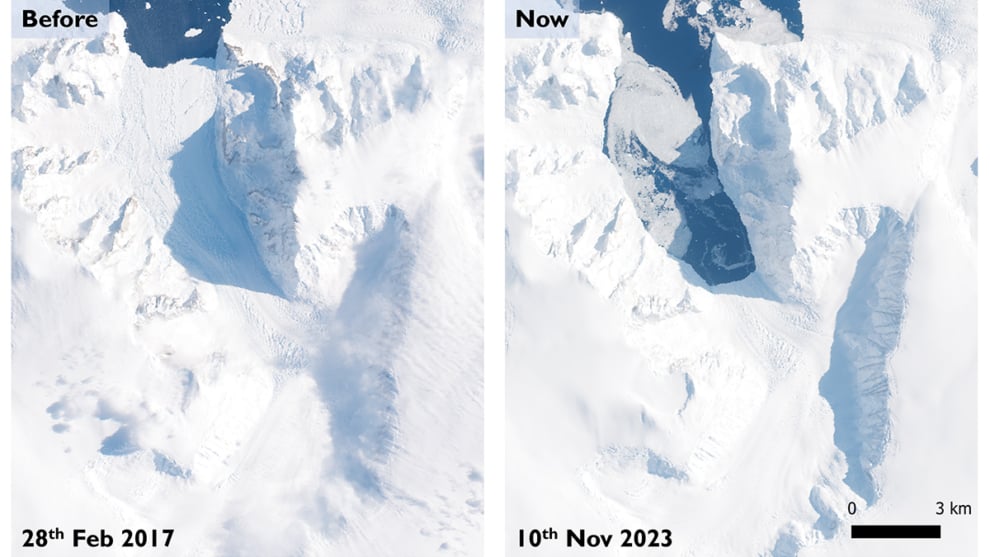

Mountainous and glacial coast of the Antarctic Peninsula.
We already know that climate warming is causing the poles to melt. But even Scientists themselves are often surprised at the speed with which it is produced. Because many seemingly stable glaciers are melting very quickly.
This is exactly what a research team led by Benjamin Wallis, a glaciologist at the University of Leeds, wanted to test. used satellites to analyze the Cadman Glacier.a gigantic mass of ice flowing into Biscochea Bay, located on the western Antarctic Peninsula.
The results of his observations were published on Tuesday in a scientific journal Natural communicationsthe team was able to verify this From November 2018 to May 2021, the glacier retreated eight kilometers.. And they managed to find the reason: an ice shelf that stretched beyond the continent to the sea collapsed.

Scientists believe that ice shelf surrounded by warmer than normal ocean waters, “lost weight” because he became ungrounded. And from there, it could no longer hold back the glacier and act as its support, slowing its movement towards the sea.
As a result, the speed of the glacier’s movement increased sharply, doubling. which led to an increase in the number of icebergs it broke away from the ice mass and began to float in the sea.
“We were surprised to see the speed with which Cadman went from a seemingly stable glacier to a glacier where we see sudden collapse and significant ice loss,” Wallis explained. “What was also curious was that neighboring glaciers in this part of the western Antarctic Peninsula did not respond in the same wayand this could teach us important lessons that will help us better predict how climate change will continue to impact this important and sensitive polar region,” he added.
The expert explained that in their study they collected data from three decades, nine different satellite missions and oceanographic measurements. on the spot understand the changes taking place in Antarctica. Something that, as Willis noted, “demonstrates how important it is to have long-term follow-up Earth’s polar regions through a series of sensors that tell us another part of the story.
According to scientists, The Cadman Glacier is currently in a state of “significant dynamic imbalance”. The glacier’s ice continues to thin, and its altitude is decreasing at a rate of about 20 meters per year. This is equivalent to the annual loss of height of a five-story building. And this results in about 2.16 billion tons of ice from the Cadman Glacier being dumped into the ocean in the form of icebergs each year.
The significance of underwater ridges
The scientific team believes warmer ocean waters have gradually “thinned” the ice shelf since the early 2000s. This process could have started as early as the 1970s. As they explain, it is likely that warm water reached the depth where the ice column of the glacier was attached to the seafloor. As a result, the ice shelf began to melt from the bottom up.
But by analyzing underwater oceanographic data, researchers noticed that a series of underwater rock structures called ridges or sills, located at depths of 200 to 230 meters, They act as a protective barrier, channeling warmer water away from the glaciers.. But they warn that increased ocean warming could undermine the ridges’ ability to protect some glaciers.
“We have known for some time that the ocean around Antarctica is warming rapidly and that this poses a serious threat to glaciers and ice sheets, leading to global sea level rise. New research shows that Seemingly stable glaciers can change very quickly, becoming unstable with almost no warning.and then thins out very strongly and retreats,” explained Michael Meredith, a professor at the British Antarctic Survey and one of the authors of the paper.
In the article, the researchers claim that What happened to the Cadman Glacier can be seen as an example of a “glaciological tipping point.”where a system in a steady state can take one path or another depending on changes in an environmental parameter.
In the case of the Cadman Glacier, the arrival of warm water into the ocean in 2018 caused will increase ice discharge into the sea by 28% over 13 months. Researchers believe other glaciers on the Antarctic Peninsula may be vulnerable to similar sudden changes due to underwater geology.
Source: El Independiente